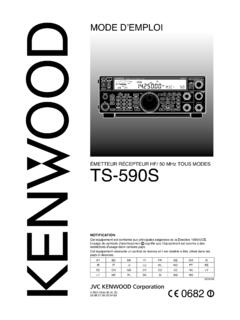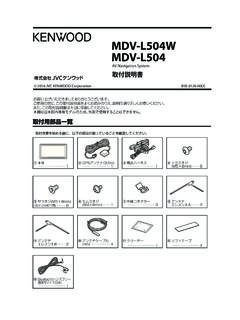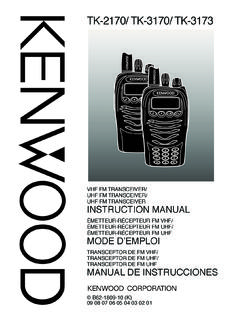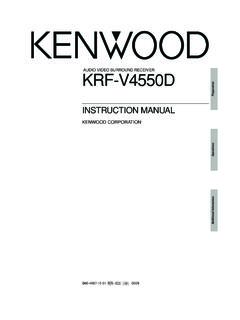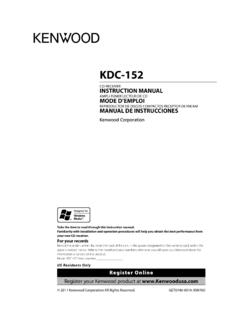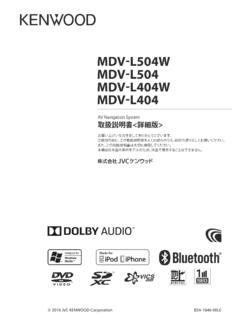Transcription of INSTRUCTION MANUAL - KENWOOD
1 B62-1509-00 (K,E,M)09 08 07 06 05 04 03 02 01 00 KENWOOD CORPORATIONINSTRUCTION MANUAL144/440 MHz FM DUAL BANDER144/430 MHz FM DUAL BANDERTM-G707 ATM-G707A144/430 MHz FM DUAL BANDERTM-G707EN-1 THANK YOU!We are grateful you decided to purchase thisKENWOOD FM transceiver. This series of mobiletransceivers was developed to satisfy the requirementfor a compact rig that s simple to operate yet containsnumerous sophisticated features. The dual bandoperation will be appreciated by hams who want accessto VHF and UHF bands with a transceiver smaller thansome single believes that the compact size, coupled withthe reasonable cost, will meet your COVERED BY THIS MANUALThe models listed below are covered by this :144/440 MHz FM Dual Bander( Canada)TM-G707A:144/430 MHz FM Dual Bander(General market)TM-G707E:144/430 MHz FM Dual Bander(Europe)FEATURESThis transceiver has the following main features.
2 Enhanced Programmable Memory (PM) channelsstore virtually entire current operating environmentsfor your quick recall. Contains a total of 180 memory channelsprogrammable with separate receive and transmitfrequencies as well as simplex frequencies, and othervarious data. Allows each memory channel to be named using upto 7 alphanumeric characters; you may assign aname such as a callsign or repeater name. Provides Easy Operation mode for hams who want touse only the basic functions for now. If programmed, the built-in Continuous Tone CodedSquelch System (CTCSS) rejects unwanted callsfrom other persons who are using the samefrequency.
3 Equipped with an easy-to-read large LCD withalpha-numeric display capability. The compact front panel is detachable from the mainunit. If used with an optional front panel kit, theseparated panel can be mounted in a convenientdifferent place. The dedicated DATA connector is available for1200 bps or 9600 bps Packet observe the following precautions to preventfire, personal injury, and transceiver damage: When operating mobile, do not attempt to configureyour transceiver while driving because it is simplytoo dangerous. Be aware of local laws pertaining to the use ofheadphones/headsets while driving on publicroads.
4 If in doubt, do not wear headphones whilemobiling. Do not transmit with high output power forextended periods. The transceiver may overheat. Do not modify this transceiver unless instructed bythis MANUAL or by KENWOOD documentation. Do not expose the transceiver to long periods ofdirect sunlight nor place the transceiver close toheating appliances. Do not place the transceiver in excessively dustyareas, humid areas, wet areas, nor on unstablesurfaces. If an abnormal odor or smoke is detected comingfrom the transceiver, turn OFF the powerimmediately. Contact a KENWOOD service stationor your dealer.
5 The transceiver is designed for a V powersource. Never use a 24 V battery to power TO THE USEROne or more of the following statements may beapplicable:FCC WARNINGThis equipment generates or uses radio frequency energy. Changes ormodifications to this equipment may cause harmful interference unlessthe modifications are expressly approved in the INSTRUCTION MANUAL . Theuser could lose the authority to operate this equipment if an unauthorizedchange or modification is TO THE DIGITAL DEVICE USER REQUIRED BYTHE FCCThis equipment has been tested and found to comply with the limits for aClass B digital device, pursuant to Part 15 of the FCC Rules.
6 Theselimits are designed to provide reasonable protection against harmfulinterference in a residential equipment generates, uses and can generate radio frequencyenergy and, if not installed and used in accordance with the instructions ,may cause harmful interference to radio communications. However,there is no guarantee that the interference will not occur in a particularinstallation. If this equipment does cause harmful interference to radio ortelevision reception, which can be determined by turning the equipmentoff and on, the user is encouraged to try to correct the interference byone or more of the following measures: Reorient or relocate the receiving antenna.
7 Increase the separation between the equipment and receiver. Connect the equipment to an outlet on a circuit different from that towhich the receiver is connected. Consult the dealer for technical condensation occurs inside the transceiver:Condensation possibly occurs inside the transceiver in such a casewhere the room is warmed using a heater on cold days or where thetransceiver is quickly moved from a cold room to a warm room. Whencondensation occurs, the microcomputer and/or the transmit/receivecircuits may become unstable, resulting in transceiver malfunction.
8 If thishappens, turn OFF the transceiver and just wait for a while. When thecondensed droplets disappear, the transceiver will function A 15 SELECTING 16 Tuning 16 Microphone [UP]/ [DWN] 17 Selecting Output 17 CHAPTER5 EASY OPERATIONCHAPTER6 MENU SET-UPWHAT IS A MENU?.. 19 MENU 19 MENU 20 CHAPTER7 OPERATING THROUGH REPEATERSREPEATER 22 Selecting Offset 23 Selecting Offset 23 Activating Tone 24 Selecting a Tone 24 Automatic Repeater Offset( Canada/ Europe Only).. 25 REVERSE 26 CHAPTER8 MEMORY CHANNELSSIMPLEX & REPEATER OR ODD-SPLIT MEMORYCHANNEL?
9 27 STORING SIMPLEX FREQUENCIES ORSTANDARD REPEATER 28 STORING ODD-SPLIT 28 RECALLING MEMORY 29 CLEARING MEMORY 29 SUPPLIED 1 CONVENTIONS FOLLOWED IN THIS 1 CHAPTER1 PREPARATION FOR MOBILE AND FIXEDSTATION OPERATIONMOBILE 2 Installation 2 Installation 2DC POWER CABLE 3 Mobile 3 Fixed Station 4 Replacing 5 ANTENNA 5 ACCESSORY 6 External 6 PACKET EQUIPMENT 6 CHAPTER2 YOUR FIRST QSOCHAPTER3 GETTING ACQUAINTEDBASIC TRANSCEIVER 8 BUTTON FUNCTION 9 FRONT 10 REAR 14 CHAPTER4 OPERATING BASICSSWITCHING POWER 15 ADJUSTING 15 ADJUSTING 15 CONTENTSiii12345678910111213141516171819 202122 NAMING MEMORY 30 SWITCHING MEMORY NAME/FREQUENCY 30 CALL 31 Recalling the Call 31 Changing Call Channel 31 MEMORY VFO 32 CHANNEL DISPLAY 32 INITIALIZING 33 Partial Reset (VFO).
10 33 Full Reset (Memory).. 33 CHAPTER9 PROGRAMMABLE MEMORY (PM)PROGRAMMABLE 34 APPLICATION 35 STORING DATA IN PM 36 RECALLING PM 36 AUTO PM CHANNEL 37 RESETTING PROGRAMMABLE 37 CHAPTER10 SCANSCAN RESUME 39 Selecting Scan Resume 39 VFO 40 MEMORY 40 Locking Out Memory 41 MHz 41 PROGRAM 42 Setting Scan 42 Using Program 43 CALL/VFO 43 CALL/MEMORY 43 PRIORITY 44 Storing Frequency in Priority 44 Selecting Priority Scan 45 Using Priority 45 CHAPTER11 CONTINUOUS TONE CODED SQUELCHSYSTEM (CTCSS)USING 46 Automatic Tone Frequency 47 CHAPTER12 DUAL TONE MULTI-FREQUENCY (DTMF)FUNCTIONS ( CANADA ONLY)MAKING DTMF 48 Mic Keypad Confirmation 48 STORING DTMF NUMBERS FOR 49 CONFIRMING STORED DTMF 49 TRANSMITTING STORED DTMF 49 CHAPTER13 PROGRAMMABLE FUNCTION (PF) KEYSASSIGNING FRONT PANEL KEY 50 ASSIGNING SPECIAL KEY 51 CHAPTER14 AUXILIARY FUNCTIONSTIME-OUT TIMER (TOT).
